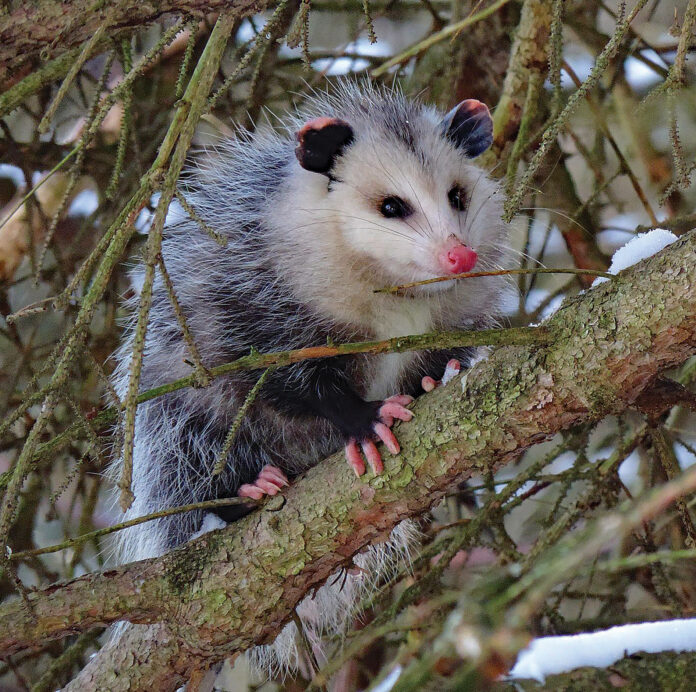
Something small had been raiding my birdfeeders at night. Although the feeders weren’t disturbed, the day’s leftovers were disappearing by morning. I switched on the floodlight hoping to glimpse a flying squirrel but instead found a tiny opossum staring back at me. I was elated!
Oh, I know the thought of these lumbering mammals with their ghostly appearance and rat-like tails illicit disgust and even fear, but hear me out. I honestly can’t think of another mammal with so many interesting, admirable traits.
First of all, the Virginia opossum (Didelphis virginiana) is not a rodent. Not even close. Rather, it is North America’s only marsupial. Marsupials are known for their fur-lined pouches in which they rear and transport their youngsters known as “joeys”.
At birth, baby opossums are premature and no larger than a honey bee. They immediately find their way into the pouch, latch onto a nipple and are carried around by the female for several months until they are large enough to fend for themselves. As they get older, they often ride around on their mother’s back.
Visually, the opossum is unique with its beady eyes, rosy nose and pink toes. Its ears and toes are hairless, making them susceptible to frostbite, as they are active year-round. The five toes on each front foot resemble a little hand, while each back foot sports an opposable thumb. This digit, without a nail, can swivel around independently to help it grip and climb. This unique arrangement of toes gives the opossum unusual, telltale prints in the snow.

In addition to its silvery fur, short legs and waddling gait, the opossum has a naked, scaley tail. This important prehensile appendage is one which the opossum cannot survive without. The animal regularly uses it to gather bunches of leaves which it then transports to its den.
And, no, an opossum does not sleep upside-down while hanging from its tail, but does use it to aid in climbing and stability. The opossum also has more teeth than any other North American mammal, 50 to be exact. When threatened, it will open its mouth and hiss, showing off its pearly whites, but will never attack.
Because the opossum has one of the lowest body temperatures of any mammal, 94 F, viruses are unable to thrive within its body. Therefore, an opossum has one of the lowest chances of any mammal to carry the rabies virus.
They are also completely immune to snake venom. This is due to a peptide found in the animal’s blood which neutralizes the poison. Scientists are currently using opossums to create an anti-venom for people who get bitten by the poisonous reptiles.
Since opossums are virtually defenseless, they have evolved an amazing way to deter predators. When threatened, an opossum will keel over, apparently dead. During one of these episodes, the animal will virtually cease breathing, its body will become stiff, its mouth will open, spilling drool onto the ground. It will also emit a dead-animal odor.
This “playing possum” episode can last up to 6 hours, during which time a predator almost always loses interest. The most interesting thing about this behavior is that it is involuntary. An opossum cannot help playing dead. Triggered by fear, it is simply a victim to its body’s reaction to feeling frightened. It’s sad to say that many an opossum has been buried alive with the thought that it was deceased when, in fact, it was not.
Opossums are omnivores. This means that they eat a wide variety of both plant and animal matter. They are also very opportunistic, consuming whatever they might come across in their travels. They love snakes, small animals, insects, eggs, berries and will happily feed on carrion and garbage.

Perhaps the opossum’s favorite food, however, is ticks. In fact, it has recently come to light that they are one of the most effective mammals at controlling the tick population. In a single season, one opossum will gobble up to 5,000 ticks. Due to this behavior, opossums have become super important in the fight against Lyme Disease because they consume the immature ticks, which harbor the disease.
Suffice it to say, the Virginia opossum is a super unique and beneficial animal to have around. No, they might not be the most beautiful creature in your eyes, but they are one of our native wildlife species and occupy an important niche in the environment. Don’t you think it’s only fair to give them the respect that they deserve?












I love these articles and I never tire of learning about nature and animals.
Unfortunately, the opossum is also a carrier of Equine Protozoal Myeloencphalitis (EPM), a neurological disease in horses that can be deadly. Horse owners cannot afford to have opossums around or near their farms. If you’ve ever seen a horse suffer from EPM, you would not want to take the chance against the positive aspects this animal brings to the farm.
Ever hear the comment “so ugly that it’s cute”?
Great informative article Tami. Thanks!
I’m with Nancy! I’m 81, grew up on a farm in Michigan where I learned a lot about the wonders of life and nature, and I’m still learning! So, YES, please keep these articles coming. They are wonderful. Thank you!
love this, thanks for this article Im using it for a school project.